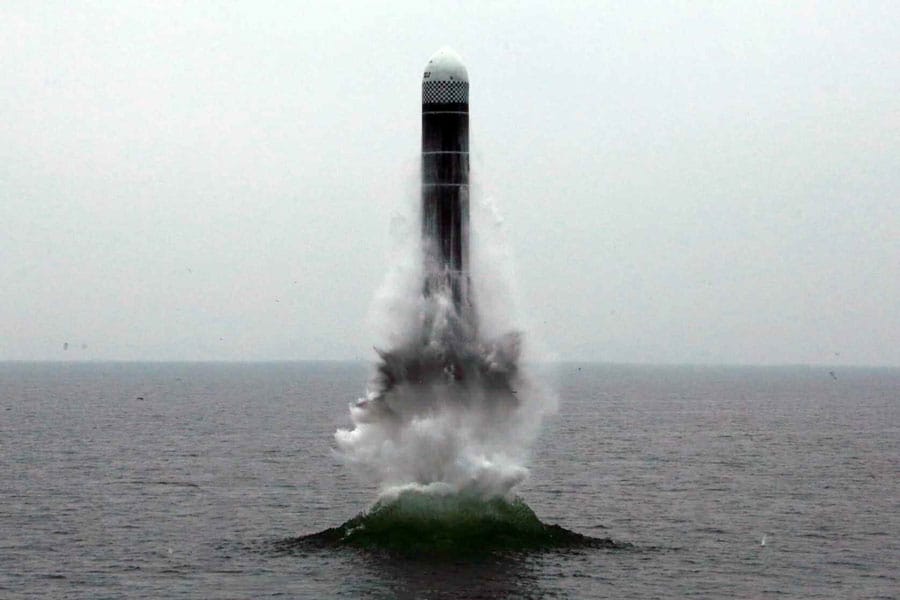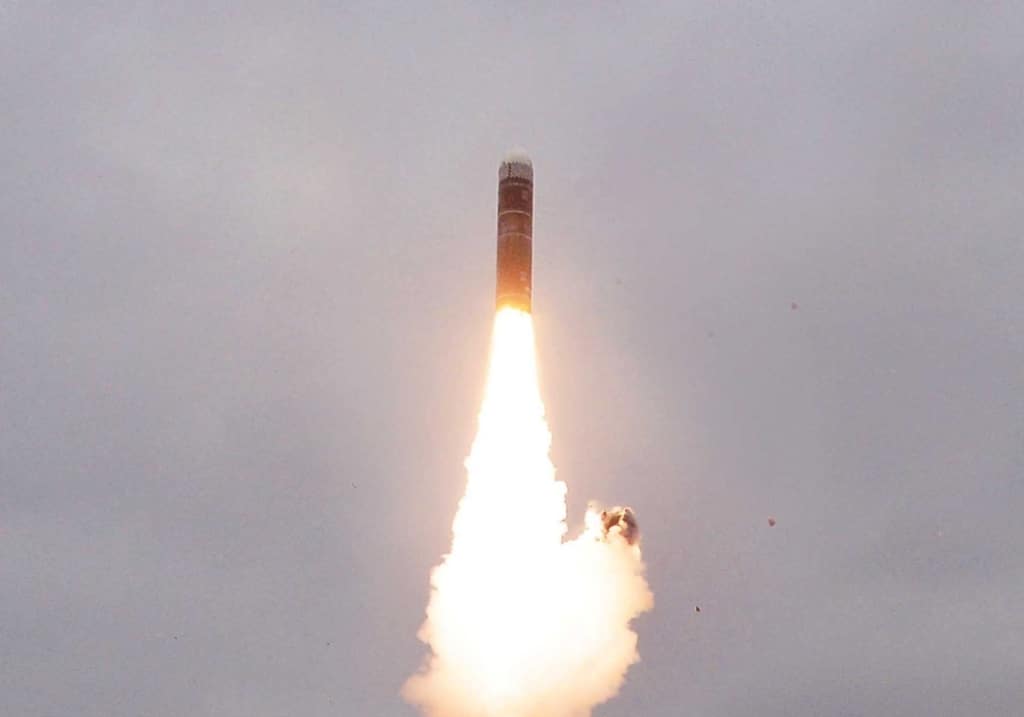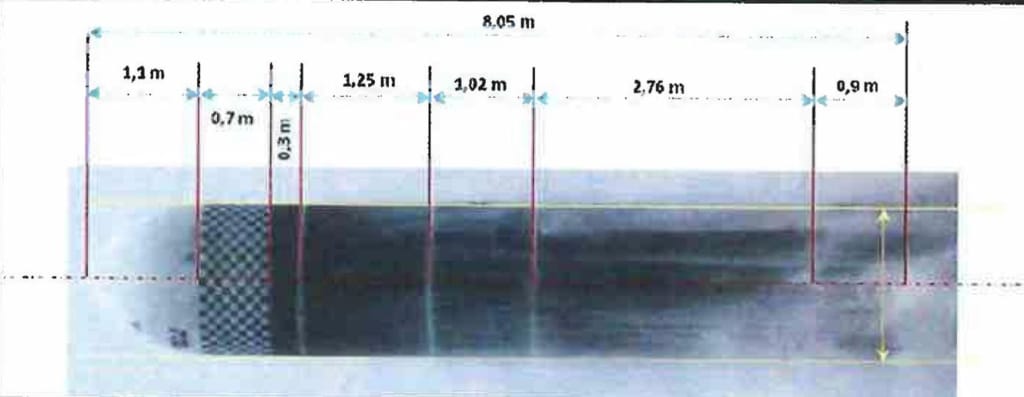The Pukguksong-3 (US designation: KN-26) is a North Korean submarine-launched ballistic missile (SLBM) with an estimated range of 1,900 km.1 After implying the program’s existence in 2017, North Korea tested the missile near Wonsan on October 2, 2019.2
Pukguksong-3 (KN-26) at a Glance
- Originated from
- North Korea
- Alternate names
- KN-26, Pukkuksong-3, Pukgeuksong-3, Bukgeuksong-3
- Possessed by
- North Korea
- Class
- Submarine-launched ballistic missile (SLBM)
- Basing
- Submarine
- Length
- 7.8 – 8.3 m
- Diameter
- 1.5 m
- Launch weight
- Unknown
- Payload
- Unknown
- Propulsion
- Solid propellant
- Range
- 1,900 km
- Status
- Unknown
- In service
- First tested 2019


Pukguksong-3 Development
North Korea first suggested the existence of the Pukguksong-3 in August 2017, revealing a diagram of the missile and new solid-fueled rocket motors at its Chemical Materials Institute in Hamhung.3 In October 2017, North Korea conducted a static test of a solid-propellant rocket motor reportedly intended for the Pukguksong-3.4 North Korea completed its expansion of solid-rocket production facilities by mid-2018.5
North Korea first tested the Pukguksong-3 on October 2, 2019, firing the missile to a 450 km range and 910 km apogee.6 In the test, the missile was ejected from an underwater platform and landed in Japan’s exclusive economic zone near Shimane Prefecture. Data gathered during the test suggests that the missile employs two stages7
Pukguksong-3 Design
Like its predecessors, Pukguksong-1 (KN-11) and Puguksong-2 (KN-15), the Pukguksong-3 is a two-stage, solid-fueled ballistic missile. The missile has an estimated length of 7.8 – 8.3 meters and diameter of approximately 1.5 meters.8
The Pukguksong-3 incorporates a cold-launch system on its aft end; after surfacing, the missile ejects its rear engine cover and ignites its main booster. Preliminary analyses of Pukguksong-3’s trajectory estimate its range at roughly 1,900 km.9

Service History
The Pukguksong-3 is believed to be built for deployment on the Sinpo-class submarine or its derivatives. On July 22, 2019, North Korean state media revealed imagery of a new class of submarine, likely designed to carry ballistic missiles.10
Further activity at North Korea’s shipyards was reported on August 26.11 However, the Pukguksong-3’s service status—and the maturity of North Korea’s submarine program—remains uncertain.
Footnotes
- David Wright, “North Korea’s Latest Missile Test, All Things Nuclear, October 1, 2019, https://allthingsnuclear.org/dwright/north-koreas-latest-missile-test.
- “DPRK Academy of Defence Science Succeeds in Test-firing of New-type SLBM,” Rodong Sinmun, October 3, 2019, http://www.rodong.rep.kp/en/index.php?strPageID=SF01_02_01&newsID=2019-10-03-0001.
- Joseph Bermudez and Dan Dueweke, “Expansion of North Korea’s Solid Fuel Ballistic Missile Program: The Eight Year Old Case of the Chemical Materials Institute,” 38 North, July 25, 2018, https://www.38north.org/2018/07/cmi072518/.
- Ankit Panda, “North Korea Has Tested a New Solid-Fuel Missile Engine, The Diplomat, October 25, 2017, https://thediplomat.com/2017/10/north-korea-has-tested-a-new-solid-fuel-missile-engine/.
- Jeffrey Lewis and Dave Schmerler, “North Korea Expanding Key Missile Site,” Arms Control Wonk, July 2, 2018, https://www.armscontrolwonk.com/archive/1205558/north-korea-expanding-key-missile-site/.
- “N. Korea presumed to have fired 1 SLBM-type missile:JCS,” Yonhap News, October 2, 2019, https://en.yna.co.kr/view/AEN20191002001257325.
- Reiji Yoshida, “North Korea fires ballistic missile built to be launched from submarine into Japan’s EEZ,” The Japan Times, October 2, 2019, https://www.japantimes.co.jp/news/2019/10/02/national/north-korea-launches-apparent-missile-japan-coast-guard/.
- United Nations 1718 Sanctions Committee (DPRK), Panel of Experts, Final report of the Panel of Experts submitted pursuant to resolution 2464 (2019), S/2020/151, (New York, NY: United Nations Security Council, March 2, 2020), https://www.un.org/securitycouncil/sanctions/1718/panel_experts/reports; Michael Elleman, “North Korea’s New Pukguksong-3 Submarine-Launched Ballistic Missile,” 38 North, October 3, 2019, https://www.38north.org/2018/07/cmi072518/.
- Wright, “North Korea’s Latest Missile Test.”
- Josh Smith and David Brunnstrom, “North Korea’s Kim inspects new submarine, signals possible ballistic missile development,” Reuters, July 22, 2019, https://www.reuters.com/article/us-northkorea-submarine/north-koreas-kim-inspects-new-submarine-signals-possible-ballistic-missile-development-idUSKCN1UH2LK.
- Joseph Bermudez and Victor Cha, “Sinpo South Shipyard: Construction of a New Ballistic Missile Submarine?” Beyond Parallel, August 28, 2019, https://beyondparallel.csis.org/sinpo-south-shipyard-construction-of-a-new-ballistic-missile-submarine/.